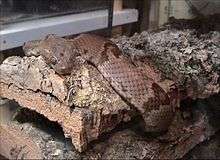Trimorphodon
Trimorphodon is a genus of mildly venomous, rear-fanged, colubrid snakes. They are commonly known as lyre snakes, named after the distinctive V shaped pattern on their head that is said to resemble the shape of a lyre. In Mexico, they are commonly called "víbora de uña," or "nail viper."[2] The word Trimorphodon is a combination of three Greek words, 'tri' - three, 'morph' - shape, and 'odon' - teeth, which refers to the three distinct kinds of teeth that lyre snakes have: recurved anterior teeth; shorter middle teeth, and large grooved fangs at the rear of the jaw. There are two distinct species in the genus Trimorphodon, with seven subspecies.
| Lyre Snakes | |
|---|---|
 | |
| Texas Lyre Snake, Trimorphodon biscutatus vilkinsonii | |
| Scientific classification | |
| Kingdom: | Animalia |
| Phylum: | Chordata |
| Class: | Reptilia |
| Order: | Squamata |
| Suborder: | Serpentes |
| Family: | Colubridae |
| Subfamily: | Colubrinae |
| Genus: | Trimorphodon Cope, 1861 |
| Synonyms | |
|
Eteirodipsas, Lycodon[1] | |
Range
Description
Lyre snakes usually grow to about 1m at adult size. They have a broad head with a narrow neck and large eyes with vertical pupils. They are tan or brown in color, with distinctive black or dark brown bands that have lighter colored borders.
Behavior
Trimorphodon species are primarily nocturnal, and feed on lizards, rodents and even bats. They are a very secretive species, and excellent climbers. They live inside rock crevices and canyon walls where humans cannot easily find them, which makes research difficult.
Reproduction
They are oviparous, laying clutches of 10 or more eggs. Hybridization between species is not unknown in the areas where their range overlaps.
Speed
There is no information on this category.
Venom
Their venom is not considered to be dangerous to humans.
Species
- Western lyre snake, Trimorphodon biscutatus (Duméril, Bibron & Duméril, 1854)
- Sonoran lyre snake, Trimorphodon lambda (Cope, 1886)
- Baja California lyre snake, Trimorphodon lyrophanes (Cope, 1860)
- Sinaloan lyre snake, Trimorphodon paucimaculatus Taylor, 1938
- Trimorphodon quadruplex (Smith, 1941)
- Mexican lyre snake, Trimorphodon tau
- Texas lyre snake, Trimorphodon vilkinsonii (Cope, 1886)
References
- Wright, A.H. and A.A. Wright. 1957. Handbook of Snakes of the United States and Canada. Comstock. Ithaca and London.
- SOS SIERRA LOS HUICHOLES, JALISCO. Under "Listado de Fauna"